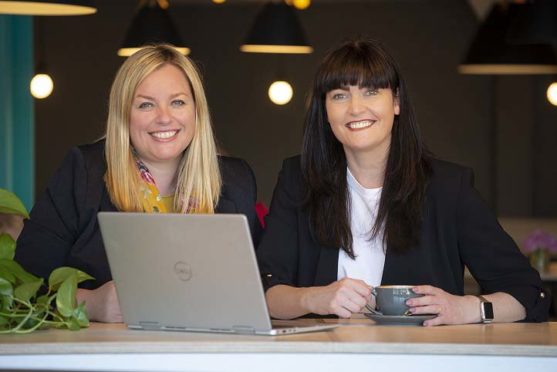Many of us have swapped our offices for our homes due to Covid-19 and that brings many changes. For businesses, supporting employees’ wellbeing has never been more important – and in some ways, more challenging – than ever.
For Fiona Lindsay and Louise Lang, wellbeing is what they do. Working with companies to create sustainable wellbeing cultures, using their backgrounds in communications and HR to great effect. And their services are definitely needed more now than ever before.
Louise explained: “We provide whole person management – which means we look at all aspects of an employee’s experience in the workplace and how it impacts their wellbeing.
“We work with companies on the development of self, team and leaders through self-awareness and coaching, as well as training on subjects including resilience and unconscious bias.
“And with so many people currently working in very unusual circumstances, employers really need to ensure they are putting a focus on wellbeing.”
Fiona added: “More than ever communication is key, – providing the most up to date information, in the correct tone, in a timely manner, through a variety of mediums to various stakeholders.
“Getting the right balance of this vital employee engagement whilst still creating opportunities for lighter interaction with colleagues is a tough ask for all organisations at the moment.
“Covid-19 is forcing change daily upon employees and organisations. Leadership, HR, health & safety and communication teams are stretched with business continuity planning.
“In times of crisis and uncertainty, employees are looking for empathy, trust, vulnerability, dialogue and authenticity.”
In the wake of the Covid-19 pandemic, Lindsay & Lang has created a Remote Engagement and Future Insight Toolkit (REFIT). This rapid response toolkit helps leaders stay connected with employees’ priorities, concerns and wellbeing during this uncertain time and provides key data for decision making about what their future business model could look like.
Fiona said: “There’s so much noise and information regarding Covid-19 which provides little opportunity for leaders to stop and listen. REFIT enables companies to establish how their employees are feeling and can assist with future planning.”
The toolkit starts with establishing a baseline through an online survey, covering key areas such as mental health, wellbeing, line manager communications and work/life balance. This provides companies with valuable feedback and data on what is working well and what support is required at that moment in time.
The subsequent phases are designed to engage, assess and inform possible future for working models for the company, particularly using employee feedback.
Louise said: “The support we are giving companies around Covid-19 is very much welcomed because they already have so much to deal with in terms of running their business in difficult circumstances, and they have not only their own wellbeing, but the wellbeing of others to think about.”
Already, it’s becoming clear that there are a lot of issues affecting employee wellness at this time. Being in a completely different working environment, having to juggle looking after children while trying to work, health anxiety, financial anxiety and concerns about job security are all factors causing stress and a deterioration of wellbeing.
“I believe that these issues are also heightened because there’s no way to get away from them,” Louise added. “You can’t hide from it.”
Fiona agreed. “And we are still in the early stages of this, so even people who feel they are coping now may start to struggle as this pandemic continues.”
However, the duo have seen some positives from the new working environment.
“People are telling us they are following their child’s schedules – they are more regimented, they have breaks and they are having lunch together – and families are going for walks together.
“People also feel they are connecting with others more, even though it’s over video calls rather than in person.”
Fiona and Louise have also provided some tips for leaders and individuals to help create good wellbeing.
For leaders
- Be present – focus on the here and now
- Be aware of emotions and negativity which could transfer to your teams
- Stay calm and considered – this will reduce panic in your teams and instil confidence
- Be vulnerable – a leader can have a tough day too. Share experiences and let yourself be seen, you’re all in this together
- Be authentic – have honest relationships and conversations
- Have compassion and empathy, understanding life from the experience and perception of another
- Remind your team what support is available
- Watch for changes in language, appearance and motivation
For Individuals
- If you are struggling reach out and talk to someone
- Be mindful and practice self-care
- Unplug – take time away from screens and turn off notifications
- Keep your routine where possible
- Be creative
- Stay connected
- Give to others and be thoughtful
- Try to have restful sleep
Lindsay & Lang have also made a workshop for employers available online so that it can be accessed remotely.
To find out more about how they can help you with your company’s wellbeing, visit the Lindsay & Lang website or contact hello@lindsayandlang.co.uk.

